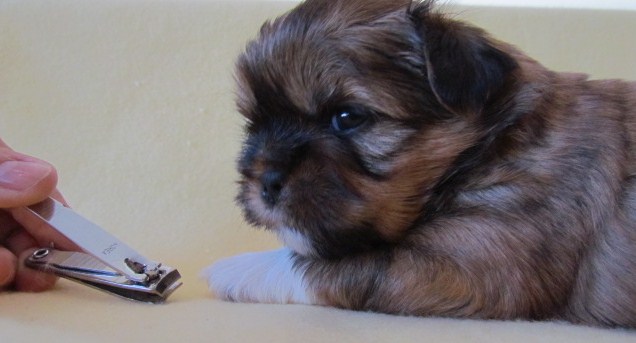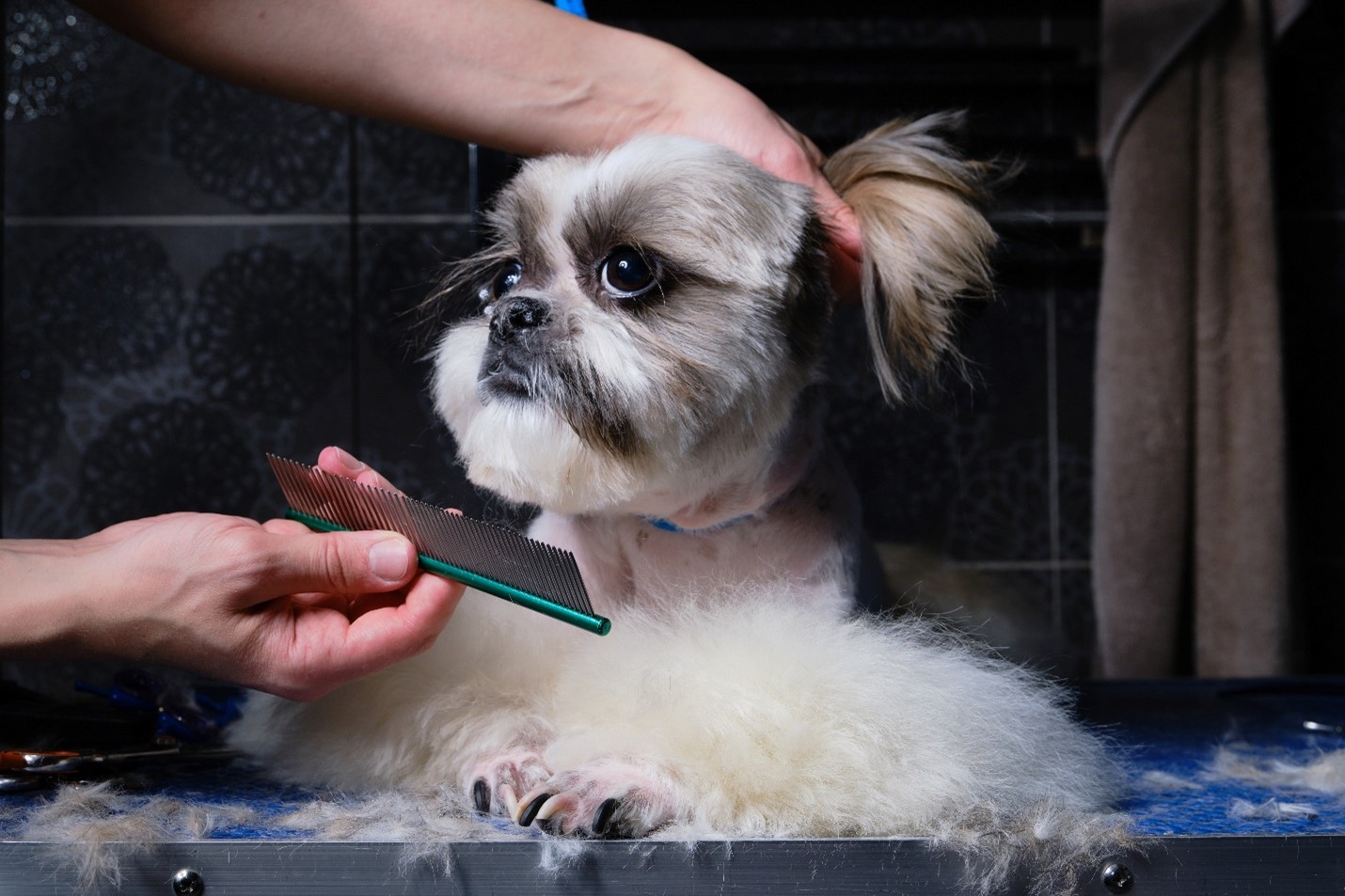How to Clip Dog Nails
How to Clip Dog Nails by Janice Jones |Last Updated 02-09-2020
So, stop dragging your Shih Tzu to the vet or groomer to get his nails clipped, do it yourself. Clipping Dog Nails is not hard and learning to do it yourself will save you time and money.
Shih Tzu nails are similar to human nails in that they grow faster when dogs are provided a high quality diet. Clipping your dog's nails should be done about every two months or more frequently.
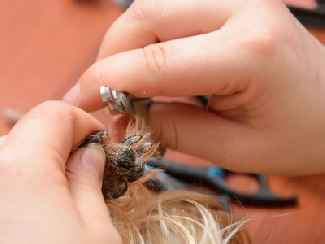 How to Clip Dog Nails
How to Clip Dog NailsIf you normally take your Shih Tzu to a groomer, nail clipping is generally part of the groom. If you like to groom your Shih Tzu at home, nail clipping becomes your responsibility.
If you have never done it before, you might want to watch a groomer or your vet trim a dog’s nails. Once you feel comfortable doing it yourself, there are a few things that you will need to keep in mind.
How to Clip Dog Nails: Nail Anatomy Lesson
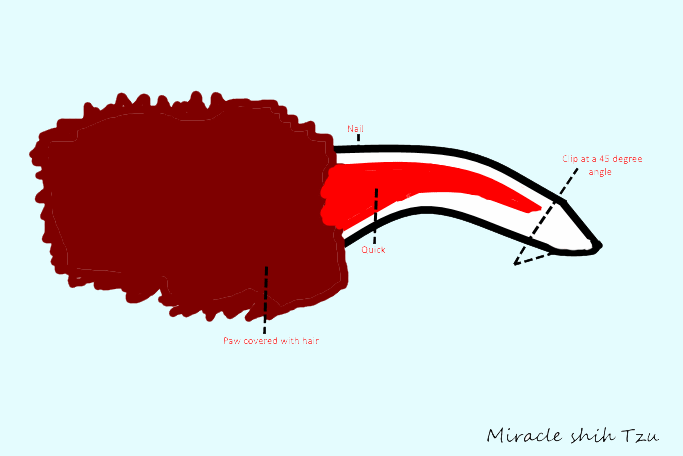 Dog Nail Anatomy
Dog Nail AnatomyIf you are going to be clipping dog nails, you should know a little about a dog's nail. Each nail has a vein running through it which can be seen if your Shih Tzu’s nails are white.
This vein appears as a pink line that runs part way up the nail. If the nails are black, you will not be able to see it or know where it ends.
The vein is called the quick and if it is cut, it will bleed and hurt the dog. Shih Tzu dogs that have had numerous experiences with their nail quick clipped become very resistant to allowing someone to clip their nails. Keep this in mind when clipping dog nails so that each experience is positive for your Shih Tzu.
How to Clip Dog Nails: Train Your Dog for the Procedure
Training your Shih Tzu to enjoy grooming in general is the first step towards comfortable nail clipping. There is not anything harder than clipping dog nails when the dog is wiggling and uncooperative.
This training starts during your puppy’s first months and continues throughout the first year.
How to Clip Dog Nails: HINT
Clip Nails when the dog is tired and right before bed. You will get less resistance!
Your breeder or (me) has handled the puppy’s paws since birth, touch them, pinching them gently, rubbing and messaging. This allows the puppy to feel comfortable with their paw’s being touched.
It’s so much easier if the Shih Tzu will lie on the table, sit, or lay on his side. Give him lots of praise when he is cooperative. Sometimes it helps if you have another person hold the dog for you, however it may not be necessary if the Shih Tzu is cooperative.
How to Clip Dog Nails: Trimmer Choices
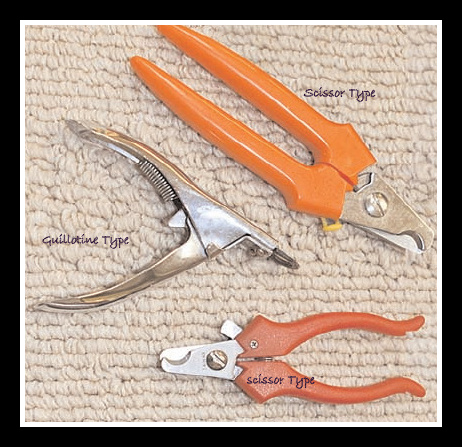
There are several styles of nail trimmers that can be used for dog nail clipping. The most common ones are the guillotine type and the scissors type.
The guillotine type is used by placing the nail between the guillotine blades and squeezing the handles together.
The scissor type as the name implies is used as if it were a scissor, placing the nail between the two blades and squeezing the handle. Both are easy to use and the choice of which to use is a matter of personal preference and comfort.
Shih Tzu Dogs with White Nails
Trimming a white nail is relatively easy. Look for the pink in the center of the nail. This pink is called the Quick. The quick is another word to describe the blood vessel that runs part way to the tip of the nail.
To cut a white nail, hold the paw gently but firmly in one hand and locate the nail. When you are dealing with a long haired breed, like ours, separate the hair from the nail.
Find the pink area of the nail and clip above it. A good rule of thumb is to clip right where the nail begins to bend, also called the “nail hook.”
If you are worried about clipping too deeply, just take a little off at a time and continue to clip until you get fairly close to the pink area. Another method is to take the tips off and clip the nails more frequently, approximately once per month.
Shih Tzu Dogs with Black Nails
Clipping a black nail is a little trickier. You will want to have some styptic powder or silver nitrate sticks available in the event that you clip a little too close.
Gauze or cotton balls will work, but blood clotting takes longer and if you do not hold the gauze onto the nail, the job can get messy.
To clip the black nails, start by cutting small pieces at a time. Each time you clip the nail, look at the end of the nail. You will eventually see the small pinkish, grayish area at the center of the nail. This is the quick and your signal to stop cutting.
How to Clip Dog Nails: Filing and Grinding
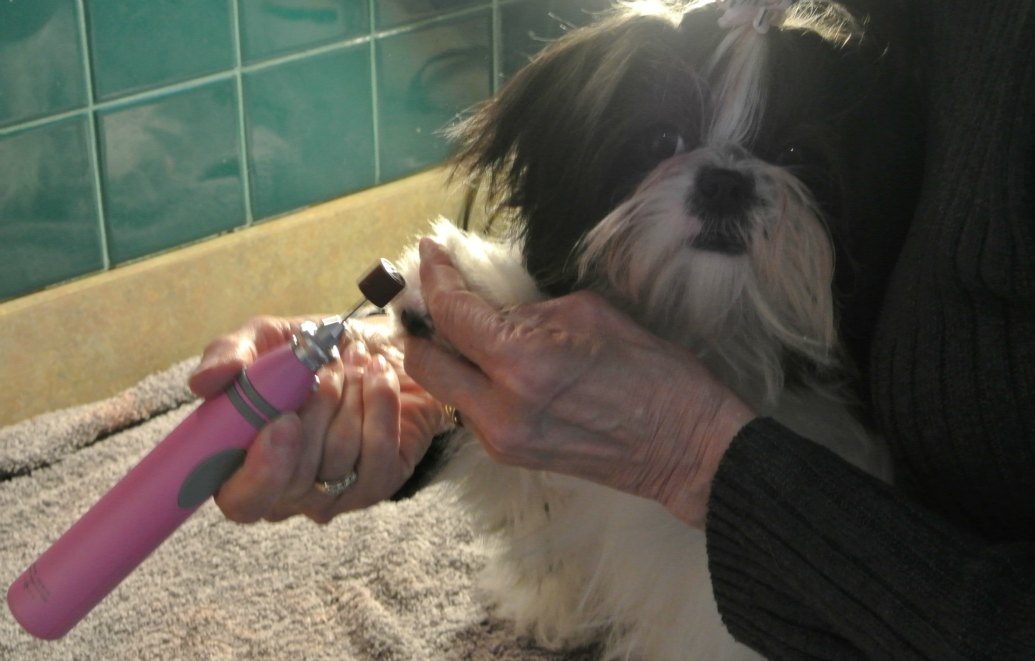 How to Clip Dog nails
How to Clip Dog nailsOnce you have clipped the nails, you may wish to use a metal file to gently file the cut area. A well filed nail is not likely to scratch anyone. This works even with young puppy nails.
You can now purchase grinding instruments that do the job too. These grinders work well for strong medium to large nails but do not work as well in tiny or small puppy nails. You can purchase a pet nail grinder, but if you already have a Dremel-type tool, it works just as well.
How to Clip Dog Nails: Fixing Mistakes
It happens to the best of us at one time or another--the dog moves, or we underestimate where the "quick" ends and accidentally trim the nail too short. Dog nails can bleed and bleed and bleed! Forget about what you learned in an elementary first aid class. You won't be able to stop the bleeding with pressure.
You won't be able to stop the steady stream of blood with a bandage. You need to have something on hand that will stop the bleeding: Styptic Powder or Silver Nitrate Sticks. Both work equally well, although the silver nitrate sticks are a little less messy.
Hint
When clipping dog nails, to remove blood stains from dog hair, dab with Hydrogen Peroxide.
Silver Nitrate Sticks: Wipe away the blood on the nail with a clean
gauze pad or tissue. Then, Simply roll the tip of the stick over the end
of the nail until you are sure the bleeding has stopped. Hold the paw
gently for a few more seconds just to be sure before releasing the dog.
Styptic
Powder: Sprinkle some of the powder on a cotton ball, gauze pad, or
tissue. Wipe away the blood on the nail with a clean gauze pad or
tissue. Place the cut nail on the gauze pad covered in powder for a few
seconds. Release and watch for any additional bleeding. Repeat if
necessary. All bleeding should be stopped before releasing the dog.
Clipping Puppy Nails
Puppies are notoriously squirmy and often protest any attempts at grooming. As with all other aspects of life, puppies need to be trained to be groomed. Any grooming task on a young puppy should be done with a firm, but gentle approach. Distracting the puppy with a treat, talking to the puppy gently, or simply holding the puppy on your lap and gently caressing him will distract him and help make your job easier.
From the moment you get your new puppy, spend some time each day to play with each foot so as to get him accustomed to someone touching his paws, pads of his feet and nails. When it comes time to clip his nails, he will be much more receptive to your grooming attempts.
It can be easier to clip the tiny nails of a toy puppy by using a human finger nail clipper. A human toe nail clipper works well with slightly larger puppies, but a regular nail clipper will need to be used for large breed dogs. Get the tip between the blades and just take of the tip, where the nail begins to curve.
Some puppies will not mind this at all and others will protest. Learn to do this quickly by holding the puppy in your lap and talk to him gently to distract him while quickly taking off the tips.

How to Clip Dog Nails: Dewclaws
Does your Shih Tzu have dewclaws? Dewclaws are similar to the thumb on the front and back paws. At birth the dewclaws are very close to the other “toes” but as the Shih Tzu grows, the dewclaws separate and eventually appear slightly higher on the leg. Sometimes a Shih Tzu will have more than one dewclaw on their foot.
Many breeders will remove dewclaws when the puppy is between 3 and 4 days old and the procedure is simple, quick and poses few problems for the newborn. If the dewclaws have been removed in this manner, you will not need to worry about them.
If your Shih Tzu has dewclaws, you want to take as much care to trim
them as they can be a source of trouble if they get caught in carpet,
fabric or bedding. If neglected, dewclaws tend to grow long and curl
around and back into the skin.
If trimmed regularly, most
dewclaws pose few problems in Shih Tzu dogs. If they do become a
problem, your vet will likely suggest that you have them surgically
removed. So, my advice when clipping dog nails is not to forget the
dewclaws.
Tips on How to Clip Dog Nails
- Choose a clipper that feels comfortable in your hand
- Find the nail’s quick and avoid clipping into it
- Cut a small amount of nail at a time
- Use a grinder or nail file to smooth over the edges of the cut nail
- Praise your Shih Tzu and give him a treat
"Hi, I'm Janice Jones, a former veterinary technician and Shih Tzu expert with over 40 years of experience with the breed. Through Miracle Shih Tzu, I combine my medical background and extensive breed knowledge to provide reliable, practical advice for Shih Tzu owners. My mission is to help you give your Shih Tzu the happiest, healthiest life possible through evidence-based information and real-world solutions. Whether you're new to the breed or a seasoned owner, you'll find trusted guidance here for all aspects of Shih Tzu care.
I hold an undergraduate degree in Psychology with a minor in biology, Early Childhood Education, and Nursing, and a Master's in Mental Health Counseling.
